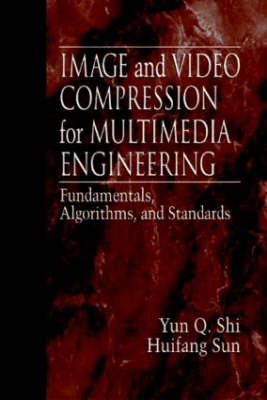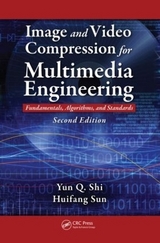
Image and Video Compression for Multimedia Engineering
Crc Press Inc (Verlag)
978-0-8493-3491-7 (ISBN)
- Titel erscheint in neuer Auflage
- Artikel merken
Advanced technologies have increased demands for visual information and higher quality video frames, as with 3-D movies, games, and HDTV. This taxes the available technologies and creates a gap between the huge amount of visual data required for multimedia applications and the still-limited hardware capabilities. Image and Video Compression for Multimedia Engineering bridges the gap with concise, authoritative information on video and image coding.
The tutorial provides a solid, comprehensive understanding of the fundamentals and algorithms of coding and details all of the relevant international coding standards. It presents recent findings on defining methods for generating high quality video bitstreams. The authors present recent research results and cover emerging technologies.
With the growing popularity of the applications that use large amounts of visual data, image and video coding is an active and dynamic field. Coverage of both image and video compression in this book yields a unique, self-contained reference, appropriate for all related professions. Image and Video Compression for Multimedia Engineering builds a basis for future study, research, and development.
PART I: FUNDAMENTALS
Chapter 1: Introduction
1.1 Practical Needs for Image and Video Compression
1.2 Feasibility of Image and Video Compression
1.3 Visual Quality Measurement
1.4 Information Theory Results
Chapter 2: Quantization
2.1 Quantization and the Source Encoder
2.2 Uniform Quantization
2.3 Nonuniform Quantization
2.4 Adaptive Quantization
2.5 PCM
Chapter 3: Differential Coding
3.1 Introduction to DPCM
3.2 Optimum linear Prediction
3.3 Some Issues in the Implementation of DPCM
3.4 Delta Modulation
3.5 Interframe Differential Coding
3.6 Information-Preserving Differential Coding
Chapter 4: Transform Coding
4.1 Introduction
4.2 Linear Transforms
4.3 Transforms of Particular Interest
4.4 Bit Allocation
4.5 Some Issues
Chapter 5: Variable-Length Coding
5.1 Some Fundamental Results
5.2 Huffman Codes
5.3 Modified Huffman Codes
5.4 Arithmetic Codes
Chapter 6: Run-Length and Dictionary Coding
6.1 Markov Source Model
6.2 Run-Length Coding (RLC)
6.3 Digital Facsimile Coding Standards
6.4 Dictionary Coding
6.5 International Standards for Lossless Still Image Compression
PART II: STILL IMAGE COMPRESSION
Chapter 7: Still Image Coding Standard: JPEG
7.1 Introduction
7.2 Sequential DCT-Based Encoding Algorithm
7.3 Progressive DCT-Based Encoding Algorithm
7.4 Lossless Coding Mode
7.5 Hierarchical Coding Mode
Chapter 8: Wavelet Transform for Image Coding
8.1 Review of the Wavelet Transform
8.2 Digital Wavelet Transform for Image Compression
8.3 Wavelet Transform for JPEG-2000
Chapter 9: Nonstandard Image Coding
9.1 Introduction
9.2 Vector Quantization
9.3 Fractal Image Coding
9.4 Model-Based Coding
PART III: MOTION ESTIMATION AND COMPRESSION
Chapter 10: Motion Analysis and Motion Compensation
10.1 Image sequences
10.2 Interframe Correlation
10.3 Frame Replenishment
10.4 Motion-Compensated Coding
10.5 Motion Analysis
10.6 Motion Compensation for Image Sequence Processing
Chapter 11: Block Matching
11.1 Nonoverlapped, Equally Spaced, Fixed Size, Small Rectangular Block Matching
11.2 Matching Criteria
11.3 Searching Procedures
11.4 Matching Accuracy
11.5 Limitations with Block Matching Techniques
11.6 New Improvements
Chapter 12: Pel Recursive Technique
12.1 Problem Formulation
12.2 Descent Methods
12.3 Netravali-Robbins Pel Recursive Algorithm
Other Pel Recursive Algorithm
12.4 Performance Comparison
Chapter 13: Optical Flow
13.1 Fundamentals
13.2 Gradient-Based Approach
13.3 Correlation-Based Approach
13.4 Multiple Attributes for Conservation Information
Chapter 14: Further Discussion and Summary on 2-D Motion Estimation
14.1 General Characterization
14.2 Different Classification
14.3 Performance Comparison Among Three Major Approaches
14.4 New Trends
PART IV: VIDEO COMPRESSION
Chapter 15: Fundamentals of Digital Video Coding
15.1 Digital Video Representation
15.2 Information Theory Results (IV): Rate Distortion Function of Video Signal
15.3 Digital Video Formats
15.4 Current Status of Digital Video/Image Coding Standards
Chapter 16: Digital Video Coding Standards - MPEG-1/2 Video
16.1 Introduction
16.2 Features of MPEG-1/2 Video
16.3 MPEG-2 Video Encoding
16.4 Rate Control
16.5 Optimum Mode Decision
16.6 Statistical Multiplexing Operations on Multiple Program Encoding
Chapter 17: Application Issues of MPEG-1/2 Video Coding
17.1 Introduction
17.2 ATSC DTV Standards
17.3 Transcoding with Bitstream Scaling
17.4 Down Conversion Decoder
17.5 Error Concealment
Chapter 18: MPEG-4 Video Standard: Content-Based Video Coding
18.1 Introduction
18.2 MPEG-4 Requirements and Functionalities
18.3 Technical Description of MPEG-4 Video
18.4 MPEG-4 Visual Bitstream Syntax and Semantics
18.5 MPEG-4 Video Verification Model
Chapter 19: ITU-T Video Coding Standards H.261 and H.263
19.1 Introduction
19.2 H.261 Video-Coding Standard
19.3 H.263 Video-Coding Standard
19.4 H.263 Video-Coding Standard Version 2
19.5 H.263++ Video-Coding and H.26L
Chapter 20: MPEG System - Video, Audio, and Data Multiplexing
20.1 Introduction
20.2 MPEG-2 System
20.3 MPEG-4 System
Each chapter also contains a summary, exercises, and references.
| Erscheint lt. Verlag | 20.12.1999 |
|---|---|
| Reihe/Serie | Image Processing Series |
| Zusatzinfo | 23 Halftones, black and white; 56 Tables, black and white |
| Verlagsort | Bosa Roca |
| Sprache | englisch |
| Maße | 178 x 254 mm |
| Gewicht | 1043 g |
| Einbandart | gebunden |
| Themenwelt | Mathematik / Informatik ► Informatik ► Web / Internet |
| Technik | |
| ISBN-10 | 0-8493-3491-8 / 0849334918 |
| ISBN-13 | 978-0-8493-3491-7 / 9780849334917 |
| Zustand | Neuware |
| Informationen gemäß Produktsicherheitsverordnung (GPSR) | |
| Haben Sie eine Frage zum Produkt? |
aus dem Bereich



